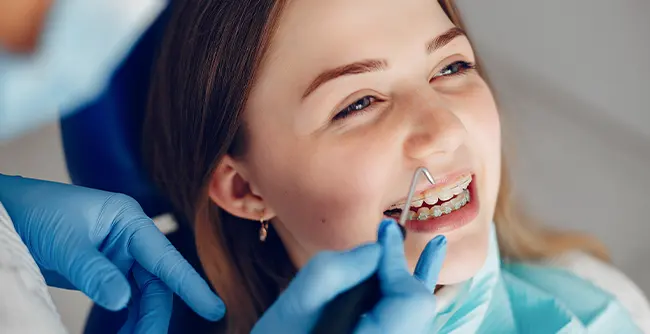
Orthodontics / Braces
We are here to help when you need us.

Orthodontics is a specialized field of dentistry that focuses on the diagnosis, prevention, and treatment of misaligned teeth and jaws. The primary goal of orthodontic treatment is to improve the alignment of teeth, correct bite problems, and enhance both the function and appearance of a person's smile. One of the most common orthodontic treatments is the use of braces. Here's an overview of orthodontics and braces:
1. Orthodontic Evaluation: The first step in orthodontic treatment is a thorough evaluation by an orthodontist, a dentist with specialized training in orthodontics. The orthodontist will assess the patient's dental and facial structure, take X-rays, and may use 3D imaging to create a treatment plan.
2. Types of Malocclusions: Orthodontists diagnose and treat various types of malocclusions (misalignments), including overbites, underbites, open bites, crossbites, overcrowding, and gaps between teeth.
3. Braces: Braces are orthodontic devices that consist of brackets, wires, and bands. They are attached to the teeth and work together to apply controlled pressure on the teeth, gradually moving them into their correct positions.
Brackets: These are small, square-shaped attachments that are bonded to each tooth's surface.
Bands: Bands are metal rings that go around the back molars to anchor the braces.
Archwire: The archwire connects the brackets and provides the necessary force to move the teeth.
4. Orthodontic Adjustment: Orthodontic patients typically require periodic adjustments to the braces. During these appointments, the orthodontist tightens or changes the archwire to continue guiding the teeth into their desired positions.
5. Retainers: After the active phase of orthodontic treatment is complete, patients are usually required to wear retainers. Retainers help maintain the new tooth alignment and prevent relapse.
6. Types of Braces:
Traditional Metal Braces: These are the most common and noticeable type of braces. They are made of stainless steel.
Ceramic Braces: Ceramic braces are less visible than metal braces because they are tooth-colored or clear. They are a popular choice for individuals who want a more discreet option.
Lingual Braces: Lingual braces are placed on the backside of the teeth, making them less visible from the front. They are custom-made for each patient.
Invisalign: Invisalign is a series of clear, removable aligners that are custom-made for each patient. They are a popular choice for adults and teenagers who prefer a more aesthetic and comfortable orthodontic treatment.
Orthodontic treatment with braces typically lasts for one to three years, depending on the complexity of the case. The exact duration and type of braces used will be determined by the orthodontist based on the individual's needs and goals.
Orthodontic treatment not only improves the appearance of the smile but also contributes to better oral health by making it easier to clean and maintain teeth, reducing the risk of dental problems such as cavities and gum disease. If you or someone you know is interested in orthodontic treatment, it's advisable to consult with an orthodontist to discuss the best options for achieving a healthy, straight smile.








